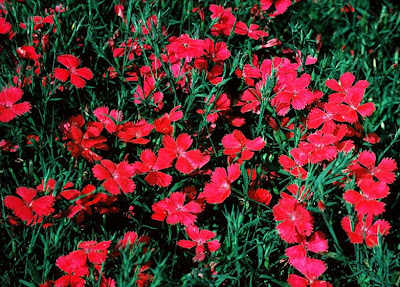Dianthus gratianopolitanus syn. Dianthus caesius 'Spotty'
Cheddar Pink, Rock Garden Pink
Type Perennial
Hardy range 3A to 9A
Height 4" to 6" / 10cm to 15cm
Spread 18" to 24" / 45cm to 60cm
Growth rate Slow
Form Rounded
Exposure Full sun
Persistence Semi-evergreen
Bloom Color Red and white
Bloom Time Summer
The flowers are fragrant and suitable for cut flowers.Environment This plant tolerates drought.
This plant will grow in dry to moist soil.
Suitable soil is well-drained/loamy or sandy.
The pH preference is a neutral soil.
Leaf Color Blue and silvery
This plant has attractive foliage.
Culture Notes Seeds can be gathered after flowering, but the plant will loose some vigor if allowed to seed. For the best appearance remove all the flower heads when most of the flowers are finished. Trim to the congestion of foliage. Division can be made after flowering. Plant with: Iberis, Armeria, Artemisia, and Phlox subulata. 'Spotty' has bicolored red and white blossoms.
Dianthus gratianopolitanus syn. Dianthus caesius
Cheddar Pink, Rock Garden Pink
Type Perennial
Hardy range 3A to 8A
Height 9" to 12" / 23cm to 30cm
Spread 8" to 12" / 20cm to 30cm
Growth rate Average
Form Rounded
Exposure Partial shade or partial sun to full sun
Persistence Semi-evergreen
Bloom Color Pink and red
Bloom Time Spring and Summer
Environment This plant tolerates some drought.
This plant will grow in dry to moist soil.
Suitable soil is well-drained/loamy.
The pH preference is a neutral to slightly alkaline (6.8 to 7.7) soil.
Leaf Color Blue and silvery
This plant has attractive foliage.
Culture Notes Seeds can be gathered after flowering, but the plant will loose some vigor if allowed to seed. For the best appearance, remove all the flower heads when most of the flowers are finished. Trim to the congestion of foliage. Division can be made after flowering. Plant with: Iberis, Armeria, Artemisia, and Phlox subulata.
Dianthus plumarius 'Ideal Violet'
Cottage Pink
Type Perennial
Hardy range 4A to 9A
Height 6" to 12" / 15cm to 30cm
Spread 12" to 18" / 30cm to 45cm
Growth rate Slow
Form Rounded
Exposure Full sun
Persistence Deciduous and evergreen
Bloom Color Purple
Bloom Time Spring and Summer
Environment This plant will grow in dry to moist soil.
Suitable soil is well-drained/loamy.
The pH preference is a neutral soil.
Leaf Color Silvery
This plant has attractive foliage.
Culture Notes 'Ideal Violet' was chosen by All-America Selection as a 1992 winner. It was the first dianthus to receive this honored bedding plant award. It has purplish-violet blossoms with a white eye. In warmer climates, the mother plant will sometimes live through the winter. Treated as an annual, this plant is often times confused for a perennial. Division should be made from first year plants. Seeds will differ from mother plant and can be collected after blooming in the summer. Plants go well with: Myosotis, Asclepias, and Gaillardia sp.
Dianthus gratianopolitanus syn. Dianthus caesius 'Dottie'
Cheddar Pink, Rock Garden Pink
Type Perennial
Hardy range 3A to 9A
Height 4" to 6" / 10cm to 15cm
Spread 8" to 12" / 20cm to 30cm
Growth rate Fast
Form Rounded and spreading or horizontal
Exposure Full sun
Persistence Semi-evergreen
Bloom Color White
Bloom Time Spring and Summer
Environment This plant tolerates some drought.
This plant will grow in dry to moist soil.
Suitable soil is well-drained/loamy or sandy.
The pH preference is a neutral to slightly alkaline (6.8 to 7.7) soil.
Leaf Color Green
This plant has attractive foliage.
Culture Notes Seeds can be gathered after flowering, but the plant will loose some vigor if allowed to seed. For the best appearance, remove all the flower heads when most of the flowers are finished. Trim to the congestion of foliage. Division can be made after flowering. Full sun is acceptable in the northern United States; however, light shade is a must in the southeast. Plant with: Iberis, Armeria, Artemisia, and Phlox subulata. Deadheading spent blossoms will increase the number of blooms.
Dianthus deltoides 'Zing Rose'
Maiden Pink
Type Perennial
Hardy range 4A to 8A
Height 4" to 6" / 10cm to 15cm
Spread 18" to 24" / 45cm to 60cm
Growth rate Fast
Form Rounded and spreading or horizontal
Exposure Full sun
Persistence Deciduous and evergreen
Bloom Color Red
Bloom Time Summer
Environment This plant tolerates drought.
This plant will grow in dry to moist soil.
Suitable soil is well-drained/loamy or sandy.
The pH preference is a neutral to alkaline (6.8 to more than 7.7) soil.
Leaf Color Green
Culture Notes Cut spent flowers to maintain neatness of the plant and to promote growth. This Dianthus can seed itself readily, so plant it where it can be allowed to spread. Plant in a gritty well-drained soil. Plants go well with: Other Dianthus sp., Thymus, Sempervivum, and Teucrium sp. D. deltoides forms loose spreading mats and blooms continuously for up to two and a half months. It's excellent when used as a ground cover.
Please feel free to comment on any post at any time all feedback is welcome and we’d love to hear it.









